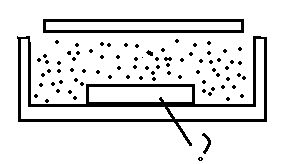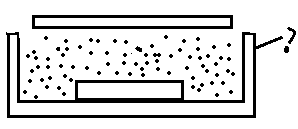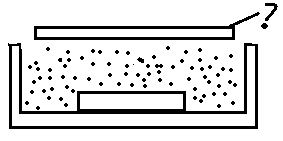This set of Casting, Forming and Welding Multiple Choice Questions & Answers (MCQs) focuses on “Molding Machines”.
1. Which of the following is not a process of ramming?
a) Squeezing
b) Quenching
c) Jolting
d) Slinging
View Answer
Explanation: Ramming of sands is considered to be one of the most important operations of molding machines. Ramming is done in a molding box. A few types of ramming operations are, squeezing, jolting, slinging and blowing.
2. Which machine is most useful for making shallow patterns?
a) Squeeze machine
b) Sand slinger
c) Jolt-squeeze machine
d) Jot-squeeze roll over
View Answer
Explanation: In a squeeze machine, there is a squeezer head or a plate which is used as a pressing board to force the sand inside or compress it. This machine is mostly used for shallow patterns.
3. Which of the following is not a power operated molding machine?
a) Squeeze machine
b) Sand slinger
c) Jolt-squeeze machine
d) Jot-sand machine
View Answer
Explanation: In the power operated molding machines, there is a use of compressed air and hydraulic machinery. There are also electromagnets used in it. These machines are classified as, squeeze machine, sand slinger, jolt-squeeze machine and sand slinger.
4. At what pressure, does the compressed air enter in squeezing machine?
a) 6 kg(f)/cm2
b) 7 kg(f) /cm2
c) 8 kg(f) /cm2
d) 9 kg(f) /cm2
View Answer
Explanation: In squeezing machines, the sand used is rammed very hard. It has a greater density at the surface than at the interiors. The air required for compression of the sand, enters at 7 kg(f) /cm2.
5. Up to what depth of molds is a squeezing machine used?
a) 10 cm
b) 12 cm
c) 15 cm
d) 18 cm
View Answer
Explanation: It is considered among one of the limitations of squeezing molding machines, that they can only be used if the mold is shallow. The depth up to which a squeezing molding machine can be used is 15 cm.
6. With an increase in the diameter of the piston, how does the molding force change?
a) Increases
b) Decreases
c) Does not change
d) Not related
View Answer
Explanation: The force needed for molding is directly related to the square of the diameter of the piston, that is, with an increase in the diameter of the piston, there will be an increase in the molding force.
7. With a decrease in the length of the jolt stroke, how will the power of jointing be affected?
a) Increases
b) Decreases
c) No affect
d) Entities not related
View Answer
Explanation: In a jolting machine, a cylinder and piston mechanism is present. The power of jolting is directly linked the length of the jolt stroke, which means, with a decrease in the length of jolt stroke, there would be a decrease in the jointing power.
8. With an increase in the jolted area, how does it affect the jolted length?
a) Increases
b) Decreases
c) No change
d) Not related
View Answer
Explanation: According to the formula of power required for jolting, the jolted area is inversely related to the length of the jolt stroke, that is, with an increase in the jolt stroke, there will be a decrease in the jolted area and vice versa.
9. Hand molding is an inexpensive process.
a) True
b) False
View Answer
Explanation: Hand molding operation need a lot of time for completion and labor effort, but, in case of molding machines, the equipment needed are costly, making the overall process an expensive one.
10. High amount of tapering allowance is required when molding machines are used.
a) True
b) False
View Answer
Explanation: In other types of castings, a tapering allowance of at least 3o to 10o is required to be given. But, when the entire process gets mechanized, the tapering allowance can be reduced, and much allowance is not required.
11. In the following squeezing machine apparatus, what does the question mark represent?

a) Diaphragm
b) Plate
c) Pattern
d) Flask
View Answer
Explanation: In squeezing machines, the operations are made to happen under some amount of pressure. In this figure, the pattern is kept with the sand beneath it. This pattern therefore will experience the upward force.
12. In the following squeezing machine apparatus, what does the question mark represent?

a) Flask
b) Pattern
c) Pressure column
d) Plate
View Answer
Explanation: In a squeezing operation mechanism, there is some amount of sand in the apparatus which is pressurized. This sand is accumulated and not allowed to spread away with the help of the flasks situated at the ends.
13. What is the minimum pressure required to be given in a squeezing process?
a) 4 kg(f)/cm2
b) 5 kg(f)/cm2
c) 6 kg(f)/cm2
d) 7 kg(f)/cm2
View Answer
Explanation: In squeezing processes, there is piston used which applies a thrusting force over the sand beneath it. There is air present which gets pressurized in the system. This air pressure, minimum has to be 6 kg(f)/cm2.
14. In the following squeezing machine apparatus, what does the question mark represent?

a) Plate
b) Air column
c) Diaphragm
d) Pattern
View Answer
Explanation: In this figure, the question mark represents the plate. In the squeezing process mechanism, there is a plate involved for taking the load from the piston and transferring it on to the sand and air present there.
15. What is the maximum pressure required to be given in a squeezing process?
a) 6.5 kg(f)/cm2
b) 7.5 kg(f)/cm2
c) 8.5 kg(f)/cm2
d) 9.5 kg(f)/cm2
View Answer
Explanation: A molding force is applied with the help of a piston in squeezing machines. This causes the air to get pressurized. This minimum pressure of the air can be 6 kg(f)/cm2 and the maximum air pressure can be 7.5 kg(f)/cm2.
Sanfoundry Global Education & Learning Series – Casting, Forming and Welding.
To practice all areas of Casting, Forming and Welding, here is complete set of 1000+ Multiple Choice Questions and Answers.
If you find a mistake in question / option / answer, kindly take a screenshot and email to [email protected]
- Check Mechanical Engineering Books
- Apply for Metallurgical Engineering Internship
- Practice Mechanical Engineering MCQs
- Apply for Mechanical Engineering Internship
- Practice Metallurgical Engineering MCQs
